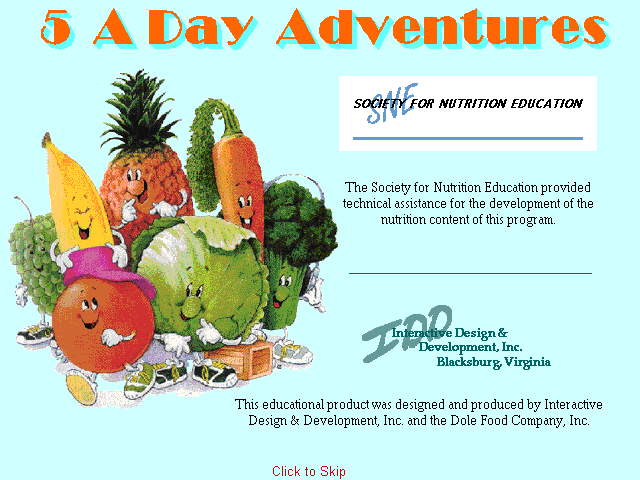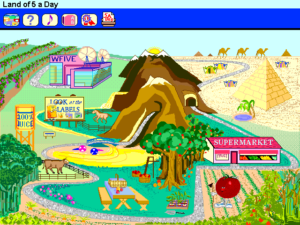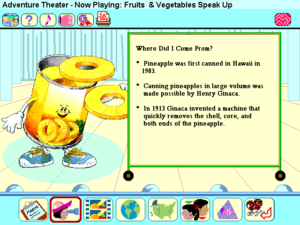5 A Day Adventures 
For better or worse, the 5 A Day Adventures CD-ROM was originally given away to elementary schools and libraries for free.1 It was meant to encourage kids to eat healthy food, but it’s also, unavoidably, an interactive ad for the Dole Food Company.
I realize that a promotional CD-ROM about fruit is sort of a ridiculous thing to write about. It almost doesn’t matter whether 5 A Day Adventures is any good, because the interesting part has less to do with the food pyramid and everything to do with the bigger colliding forces at work in the worlds of education, software, and public relations that produced this thing.
Looking at the final product, you can tell that the creators of 5 A Day Adventures tried their best to make health education sound like fun. It’s right there in the title: this informational CD-ROM is supposed to be an adventure. When you fire up the game, you’re greeted by Bobby Banana, a totally radical skateboarding banana, who served as an on-and-off mascot for Dole.2 He’s your tour guide through the world of nutrition. First he takes you to Banana Boulevard, a small-town street where the fruits and vegetables hang out. Then it’s off to the Land of 5 a Day, a sprawling picnic world that teaches kids about serving sizes and food labels. Bobby Banana works at the local radio station here, blasting tunes about veggies and vitamins for all the food-people.
There’s something alarming about the fact that there’s only a single human who lives on Banana Boulevard and there’s a cafe in town where the vegetables cook and eat other vegetables, but I assume we’re not supposed to read too much into this.
There’s a dozen activities to do around town, each with a goofy character who teaches you about healthy eating. You can go to the theater to watch Pamela Pineapple put on a show where the fruits and vegetables share facts about themselves – did you know that most cauliflower is grown in California? – or you can make a healthy salad at the Salad Factory. At the end of each section, the game gives you a quiz, and you can earn a certificate that proves you know your stuff about fruits and veggies. The breadth of the material covered by 5 A Day Adventures is surprisingly large, but that’s also why the game feels so awkward.
For context, this CD-ROM was developed as part of a larger public health initiative. Dole was a member for the 5 A Day Better Health Program, a nationwide campaign that partnered up with the food industry to encourage kids to eat more fruits and vegetables,3 and as more schools were starting to use computers in the 90s, Dole saw there was an opening to be the first to the market with a nutrition education CD-ROM.4 It was as much a piece of educational software as it was a PR move; the marketing push for 5 A Day Adventures was overseen by Ketchum PR, a firm that does advertising work for the food and beverage industry, which booked the CD-ROM a spot on NBC’s Today show.5
Quite a few different parties were invested in 5 A Day Adventures. Based on the credits, most of the content seems to have been designed by Dole’s director of nutrition and health Lorelei DiSogra,6 along with input from the Society for Nutrition Education. Besides communicating the messages of the 5 A Day Program, it also needed to be an ad for Dole, and it also covers new developments in nutrition policy, like the newly redesigned Nutrition Facts label that was mandated in the United States by the Nutrition Labeling and Education Act of 1991. In short, the CD-ROM had a glut of content that it needed to feature, and you can feel it bogged down by all those obligations.
5 A Day Adventures seems to be hitting specific bullet points that the stakeholders wanted to include, even if they’re a poor fit for the program. If the goal was to get kids excited about eating fruits and vegetables, it really doesn’t matter that most cauliflower is grown in California, but that must have been on a list of vegetable facts that the developers were told to put in. Even the wacky food characters speak in terms of bullet points. In the dried fruit aisle of supermarket, Calvin Carrot tells you that “There are three messages to discover,” as if Dole was required to include three specific pieces of information about shopping for dried fruit, and Calvin Carrot has been court-ordered to tell you about them.
There’s a disconnect between the fanciful world of fruit that 5 A Day Adventures takes place in and the material that these characters are forced to cover. I don’t doubt the sincerity of Dole’s nutrition team trying to do something good within a promotional product like this, because it does make an effort to get kids interested in healthy food. Some ideas work, and some don’t. It attempts to talk to kids on their level, like when it compares reading a nutritional label to “being a detective,” or when it asks kids about their favorite foods. But then too much of the remainder of the program is like vegetables reading a factsheet in a silly accent.
There are a few sing-a-longs wedged in too, but they’re banal even for a children’s computer game about nutrition. The lyrics to the song about Vitamin A are mostly just telling you that they’re singing a song about Vitamin A. It’s really, really awful, like the composer had five minutes to write a song about Vitamin A.
The game sits in a sticky intersection of education, advertising, and digital publishing. Dole was drawn to the idea of producing a CD-ROM in the first place because educational software was a booming format with a ton of interest from families and teachers. (The internet was rapidly growing too, so Dole also put up a 5 A Day Adventures website that let kids send emails to a Bobby Banana, or at least a Dole employee pretending to be Bobby Banana.4) When the game was released for the general public at a budget price of $14.95, it was not only sold at software retailers but also, surprisingly, at supermarkets, where a parent might already be buying Dole-branded food products.7,8 Making a nutrition CD-ROM was a means to an end – the cooler, buzzier way to do advertising.
This wasn’t an isolated case either. Ketchum PR, the company than ran Dole’s PR for 5 A Day Adventures, was also responsible Building a Better Salad: Good News at the Top!, a free program designed for the Wish-Bone salad dressing brand, which had a similar double-headed goal to teach users about nutrition while also plugging a food brand.5,9 A program like that could have easily just been relegated to an information box on the back of a food package that nobody would read. During the CD-ROM boom – an era with niche CD-ROM encyclopedias and ballooning interest in educational software – it seems that food companies, nutrition groups, and marketing firms all realized you could turn a list of salad tips into a product.
Dole sent around 20,000 copies of 5 A Day Adventures to teachers,4,5 and counting copies of the software that were bundled with Macintosh computers, they eventually distributed 270,000 CD-ROMs.4 It was a surprising success for Dole, enough that five years later, they developed a second edition of the program, with more focus on physical activity.
Isn’t it amazing that Dole distributed a quarter-million copies of a corporate PSA? If it wasn’t a computer game, it would have just been a packet of worksheets given to schools, and it wouldn’t have had nearly the same reach. While the concept of selling software in supermarkets didn’t pan out for the industry,10 CD-ROMs were still an exciting and novel format for something like this in the mid-90s. The sales numbers must have looked great to Dole executives.
5 A Day Adventures works best when it’s trying to have fun with kids. Most of the time though, it seems like the actual audience for this game was the organizations that made it.
References
1. Singer, Linda A. (1994, March). School of thought. CD-ROM Professional, 7(2), p.146. Retrieved from https://search.proquest.com/docview/224108354
2. Zbar, Jeffery D. (1997, March 31). Move over raisins, says Dole’s ‘Bobby Banana.’ The Sun-Sentinel. Retrieved from https://www.sun-sentinel.com/news/fl-xpm-1997-03-31-9703280149-story.html
3. Center for Disease Control and Prevention. (2005). 5 A Day Works!, p.v. Retrieved from https://www.cdc.gov/nccdphp/dnpa/nutrition/health_professionals/programs/5aday_works.pdf
4. Wheelock, Verner (Ed.). (1997). Implementing Dietary Guidelines for Healthy Eating. Blackie Academic & Professional, p.462-495. Retrieved from https://www.google.com/books/edition/Implementing_Dietary_Guidelines_for_Heal/ftC9suGxewsC
5. Ketchum adds high-tech touch to food drives. (1994, March). O’Dwyer’s PR Services Report. Retrieved from LexisNexis
6. Riemenschneider, Pamela. (2017, June 23). The legacy of Lorelei DiSogra. Produce Retailer. Retrieved from https://www.produceretailer.com/article/blog-article/legacy-lorelei-disogra
7. Future Vision Multimedia forms strategic alliance with Dole Food Co. (1995, April 18). Business Wire. Retrieved from LexisNexis
8. SoftKey Int’l and Dole Food team up. (1995, September 11). Multimedia Week, 4(36). Retrieved from Factiva
9. Morandi, Kari. (1993, August 3). Wish-Bone lets computer buffs analyze their salads’ nutrients. Deseret News. Retrieved from https://www.deseret.com/1993/8/3/19059278/wish-bone-lets-computer-buffs-analyze-their-salads-nutrients
10. Alaimo, Dan. (1996, July 8). CD-ROM Growth Lies Ahead for Supermarkets. Supermarket News, 46(28), p.39. Retrieved from LexisNexis




A teacher demonstrated this software for my class when I was in 2nd grade. We didn’t get a chance to commandeer it for ourselves, but the teacher made it to the Salad Factory activity. That somehow hooked me; for a while afterwards, I wanted to get my hands on 5 A Day on the strength of the Salad Factory alone! Mind you, the school district’s commitment to healthy eating didn’t extend to their lunch program; they gave us delicacies such as “Dunkers and Dips” (3 breadsticks, plus your choice of a little cup of peanut butter or queso).
This sounds like hot garbage, I love it!
It’s tough for me to even think about something like this in terms of being good or bad, because it’s so much a product that that’s the most interesting part to me! Like there are places where it’s not great – Vitamin A! – but the quality is secondary for me to trying to understand who this was made for and why.
I played Vitamin A for my one-year-old and he was not impressed. But I guess this corporate propaganda masquerading as edutainment worked on some!
This really reminds me of Power4Bones. This was a Flash games site (the CD-ROM of my generation! I mean I guess…) which was all about getting enough exercise and drinking enough milk to grow strong bones. The website is unfortunately gone now.
My school was encouraged to use it, and Power4Bones had a kit of stuff for teachers to give out to students. They had these comics, which I thought were the coolest thing ever, and the teacher would hand out a new one every week. It featured the protagonist, Agent Bones, coming to Earth from a distant planet where the aliens are struggling to research why they have such fragile bones. There was also the evil villain trying to stop Agent Bones from discovering the secrets of milk and exercise, Dr. Trippenfall.
There was a “secret code” you could learn where you’d decrypt messages about what foods were dairy products (milk, cheese, yogurt…) or how much time you should spend exercising in a day, or how milk was an excellent source of vitamin D and calcium.
All of it was of course trying to get you onto the Power4Bones website which had Flash based games. There was one where you were at a grocery store and had to buy the products that were the best for your bones (with dairy products of course being the ones you had to buy the most of to win.) I remember you could buy vegetables but buying them wouldn’t help you win, which maybe sent the wrong message, but it wasn’t the product they were trying to push of course.
Huh… I feel like I played this, long ago? The character art on the front page really gives me strong vibes of having seen it before, especially the orange with the hat. But I don’t exactly remember the rest of the game…
Oh geez, I just looked up Salad Mixer and I totally remember that screen now. Huh. Weird how there’s just all these memories that build up in the back of your head but are almost totally forgotten… That grainy 90s educational video has such a specific vibe.
I remember playing this game as a kid. It didn’t motivate me to eat much healthier but I thought traveling around the various areas and learning veggie facts was neat.
I loved this game!, my siblings and I played it when we were kids. Bobbie Banana and Pamela Pineapple were my favorites.
Thank you for posting this! The memories
I played this game as a kid and its been haunting my memories ever since! Your review finally inspired me to find it and run it on an emulator. Haven’t gotten too deep into it again, but I think what partially hooked me was the strange “productness” of it. Even now, I love sci-fi novels with strange voids and minimal human presence. This game probably had a lot to do with that. What I remember best was the Salad Factory: the austere, lonely sound of a single salad dispenser echoing in a giant a factory…. was formative somehow.
I rented this from my local library in Massapequa NY (The Bar Harbour building). At the time I had a 486 packard bell sx33 with “indeo video” capabilities. I was eager to get my hands on any software that could do full motion video, even as grainy as it was – the fact that a shiny little disc could contain on demand video was absolutely mind blowing to my 10 year old mind. It still is a miracle.